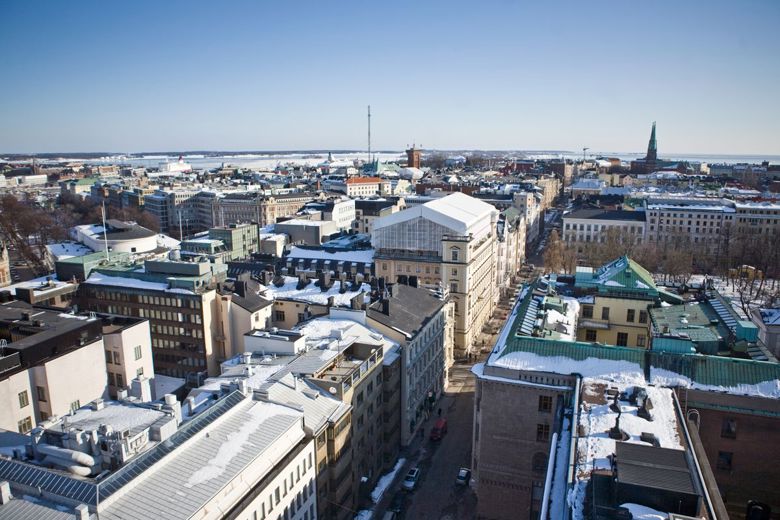Air quality in the Helsinki metropolitan area and elsewhere

In Finnish cities, the main challenges to air quality are traffic exhaust gases, street dust, and wood burning. The highest concentrations are usually measured in the Helsinki metropolitan area, but street dust and wood burning also degrade air quality in many smaller cities. The highest concentrations of fine particles in the metropolitan area are due to particles transported from other parts of Europe and local emissions.
Air Quality in the Nordic Countries
The Nordic capitals face similar air quality challenges. The most significant local emissions affecting air quality come from car traffic. Nitrogen dioxide concentrations caused by traffic are quite similar in all Nordic capitals. Traffic exhaust emissions have significantly decreased over the years as the vehicle fleet has been renewed and electrified.
However, street dust remains a problem. Car tires grind asphalt, and traffic raises dust into the air. In most Nordic countries, winter tires are necessary, and they wear road surfaces more than summer tires. Therefore, especially in spring, there is a lot of street dust in the air. In Denmark, however, there are fewer winter days, and there is no requirement for winter tires.
In addition to traffic emissions, wood burning is a locally significant source of fine particles. Particularly in winter, particles from wood burning float in the air. Households use wood mainly for heating. An exception in the Nordic countries is Reykjavik, where wood is not burned. In Iceland, almost all homes are heated with geothermal energy.
Fine particle concentrations are strongly influenced by long-range transport. Copenhagen’s air contains more fine particles transported from outside the country’s borders than other Nordic capitals. The city is closer to Western and Central Europe, with a lot of population, traffic, and extensive agriculture. All these factors increase regional fine particle concentrations and affect Copenhagen’s air quality.
Reduction of Dusty Days by Limiting Studded Tires and Street Maintenance
Stockholm has managed to reduce the number of dusty days through studded tire ban streets and enhanced street maintenance. In Oslo, studded tire usage fees are in place. Studded tires can be used there, but a fee must be paid. This has significantly reduced the number of studded tires and the wear on road surfaces caused by them. Additionally, traffic volumes and emissions have been reduced through congestion charges and environmental zones.
In the Helsinki metropolitan area, the number of dusty days has been significantly reduced through enhanced street maintenance. Methods for preventing slipperiness have been developed to be as dust-free as possible, and streets are cleaned as quickly as possible in the spring. Additionally, dust is controlled by wetting the streets with a dilute salt solution (calcium chloride) during the worst dust days.
Air Quality Elsewhere in Europe
The air in the Helsinki metropolitan area is relatively clean compared to other similarly sized urban areas. Most of the time, our air quality is good or satisfactory. There is no significant air-polluting industry in the area. The terrain is favourable for air quality. We are not surrounded by mountains; the metropolitan area is relatively flat. Additionally, there is usually always a bit of wind by the seaside. Thus, air pollutants can disperse more easily.
In most European cities, car traffic has the most significant impact on air quality. Cities have a lot of people, so traffic is busy and often congested. Of course, other forms of transport also pollute. For example, Rotterdam has the largest port in Europe, so both shipping and other port traffic degrade air quality in its vicinity. Additionally, there is chemical and energy industry in the port area. Large airports affect the air quality of cities, such as in Amsterdam. The car traffic to and from the airport is a significant factor in addition to airport operations, just like in the case of ports.
Air quality challenges vary across Europe due to differences in terrain. In the Helsinki metropolitan area, the terrain is more favourable for air quality compared to cities like Athens or Turin. The metropolitan area is flat, and there is usually some wind by the sea. In Italy’s Po Valley, air pollutants do not mix effectively and remain trapped at the bottom of the valley. In addition to heavy traffic, the Turin area has air-polluting industries. Although Athens is by the sea, it is surrounded by mountains.
Additionally, a warmer and sunnier climate causes air quality problems when there are many different pollutants in the air. In both Turin and Athens, traffic and industrial air pollutants form health-damaging ozone in the summer.
In Poland and the Balkans, household coal or wood burning significantly degrades air quality. As a result, concentrations of fine particles and benzo(a)pyrene are remarkably high in these regions.